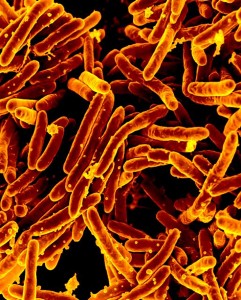An infection is defined as the invasion of the body by microscopic organisms. A pathogen is any agent that can cause a disease, but the term is usually used to describe a microbe. Microscopic germs cause injury to tissues in a number of ways, often by producing toxic substances that damage the cells.
Before we give every micro-organism a bad name, it’s important to know that they are not all pathogenic. In fact, some are beneficial or even necessary for human life, such as many intestinal bacteria.
Pathogens are often carried by “vectors”, from the Latin word vectus, “one who carries”. These are humans, animals, or microbes that carry and transmit a pathogen to others. A vector does not have to be ill to carry a disease: A mosquito, for example, carries the organism that causes malaria in humans but doesn’t experience the disease.
Another example of a disease vector was a domestic servant known as “Typhoid Mary”. She carried Typhoid fever to many people at homes where she worked without feeling sick herself. The elimination of a vector from the environment (terminating Mary’s employment, for example) usually ends the outbreak of disease.
BACTERIA
There are a number of different pathogens that cause infectious disease. Perhaps the one we hear most about is bacteria. By the way, the word bacteria is the plural form. A single one is called a bacterium.
Bacteria were among the first life forms on Earth and are present everywhere from the soil to the bottom of the ocean to the inside of your body. They may even exist on Mars. If you took the entire population of bacteria on the planet, they would probably have a mass about equal to the entire plant and animal population combined.
Bacteria have a number of shapes, ranging from spheres to rods to spirals. When bacteria reach a certain size, they reproduce by splitting in two, a process called binary fission.
 The Survival Medicine ...
Best Price: $38.70
Buy New $39.89
(as of 11:20 UTC - Details)
Many bacteria are good guys. Some, however, are pathogens and cause infectious diseases, including cholera, syphilis, anthrax, leprosy, and bubonic plague. The most common fatal bacterial diseases affect the lungs, with tuberculosis alone killing about 2 million people a year, mostly in underdeveloped countries.
The Survival Medicine ...
Best Price: $38.70
Buy New $39.89
(as of 11:20 UTC - Details)
Many bacteria are good guys. Some, however, are pathogens and cause infectious diseases, including cholera, syphilis, anthrax, leprosy, and bubonic plague. The most common fatal bacterial diseases affect the lungs, with tuberculosis alone killing about 2 million people a year, mostly in underdeveloped countries.
There are many different types of bacteria. Most bacteria don’t need to enter the host’s cells to reproduce, they do just fine in, for example, your blood. A subgroup of bacteria called Rickettsia, however, does depend on entry, growth, and reproduction within a host cell.
Rickettsiae are the cause of typhus, Rocky Mountain spotted fever, and a number of other infectious diseases. Rickettsia do not, however, cause rickets, a deformity of long bones in young children which is a result of vitamin D deficiency.
Although many bacteria have become resistant, they can usually be killed with antibiotics. Different bacteria are sensitive to different antibiotics.
VIRUSES
Viruses are microscopic pathogens that, unlike most bacteria, can reproduce only inside the living cells of other organisms. Viral particles without a host are known as “virions”, and only act as a living organism when they enter a host cell. Indeed, they stretch the definition of life itself. Viruses can infect all types of hosts, from animals and plants all the way down to bacteria.
Examples of common human diseases caused by viruses include the common cold, influenza, chickenpox, rabies, hepatitis, herpes, Ebola, and Zika.
Viruses can be spread by:
• Mosquitoes and other vectors
• Airborne droplets in coughs or sneezes
• Contact with blood or other bodily fluids
• Ingestion of contaminated food or water
A normal immune system can often kill the infecting virus. However, some viruses evade these immune responses and result in chronic infections, such as HIV or Hepatitis C. There are antiviral drugs, but it’s important to know that antibiotics have no effect.
PROTOZOA
Protozoa are one-celled microbes, a step up on the scale as they exhibit animal-like behavior, such as the ability to move. Many have a tail-like appendage called a flagella that they whip around for locomotion. They are restricted to moist or aquatic environments. Therefore, transmission is mostly by drinking contaminated water, although some are transmitted by animal vectors.
Protozoa cause infectious diseases in humans such as malaria, giardia, some dysenteries, sleeping sickness, and amoebiasis. A common vaginal infection is caused by a protozoan called trichomonas.
Protozoa are usually susceptible to treatment with certain antibiotics, such as metronidazole (also known as Fish-Zole in its veterinary equivalent).
FUNGI
A fungus (plural form: fungi) is a microorganism family that consists of such yeasts and molds. Fungal infections most commonly affect skin and mucous membranes like the oral cavity and vagina, but can invade other areas. Fungus affecting the toes is known as tinea pedis, or “athlete’s foot”. “Ringworm” is another type of fungal infection. Severe internal fungal infections can occur in individuals with weakened immune systems. Anti-fungal medications exist in topical or oral form, like miconazole or clotrimazole.
These are just some of the hazards that you’ll face if you take responsibility for the medical well-being of others in times of trouble. Learn about them, get some training and skills, and you’ll keep it together, even if everything else falls apart.
Reprinted with permission from Doom & Bloom.









